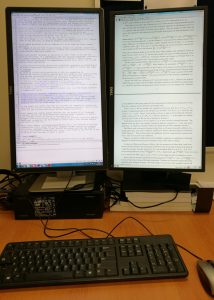A student claimed that fewer inspiring people are found in universities than in early school. Empirical checks of this would be interesting and would need a measure of inspiringness. A theoretical explanation is a tradeoff between multiple dimensions: subject matter competence, integrity, reliability, communication skills, being inspiring, etc. The tradeoff is on both the demand and the supply side. An inspiring competent person has many career options (CEO, politician, entrepreneur) besides academia, so fewer such people end up supplying their labour to the education sector.
On the demand side, a university has to prioritise dimensions on which to rank candidates and hire, given its salary budget and capacity constraints on how many job positions it has. Weighting competence more leaves less emphasis on inspiringness. Competing universities may prioritise different dimensions (be horizontally differentiated), in which case on average each institution gets candidates who have more of its preferred dimension and less of other dimensions.
As a side note, what an organisation says its priorities are may differ from its actual priorities, which are evidenced by behaviour, e.g., who it hires. It may say it values teaching with passion, but hire based on research success instead.
A constraint is a special case of a tradeoff. Suppose that given the minimum required competence, an employer wants to hire the most inspiring person. The higher this level of competence (teaching PhD courses vs kindergarten), the fewer people satisfy the constraint. At a high enough level of the constraint, there may be insufficient candidates in the world to fill all the vacant jobs. Some employers cannot fill the position, others will have just one candidate. Maximising inspiringness over an empty set, or a set of one, is unlikely to yield very inspiring people.
It may be inherently simpler to inspire with easier material, in which case even with equally inspiring people throughout all levels of education, the later stages will seem less inspiring.
Larger leaps through theory may be required as a subject gets more advanced, leaving less scope for inspiring anecdotes and real-life examples. The ivory tower is often accused of being out of touch with common experience. Parting with everyday life is partly inevitable for developing any specialised skill, otherwise the skill would be an everyday one, not specialised.
If inspiring people requires manipulating them, and more educated individuals resist manipulation better, then inspiring people gets more difficult with each level of education. Each stage of study selects on average the more intelligent graduates of the previous stage, so if smarter people are harder to manipulate, then those with higher levels of education are harder to inspire. On the other hand, if academics are naive and out of touch with the ways of the world, then they may be easier to manipulate and inspire than schoolchildren.
People accumulate interests and responsibilities in their first half of life. The more hobbies and duties, the less scope for adopting a goal proposed by some charismatic person, i.e., getting inspired by them. Later in life, many goals may have been achieved and people may have settled down for a comfortable existence. They are then less inclined to believe the need to follow a course that an inspiring person claims is a way of reaching their goals.
